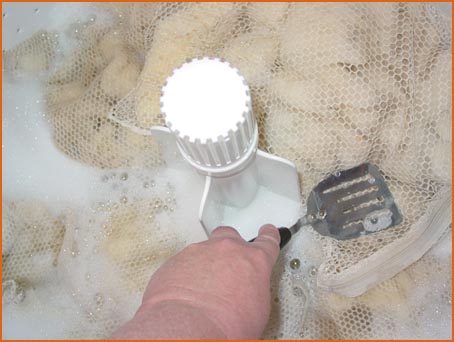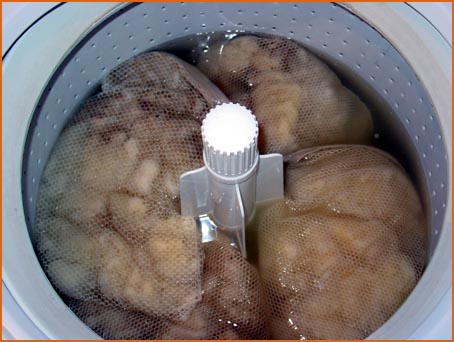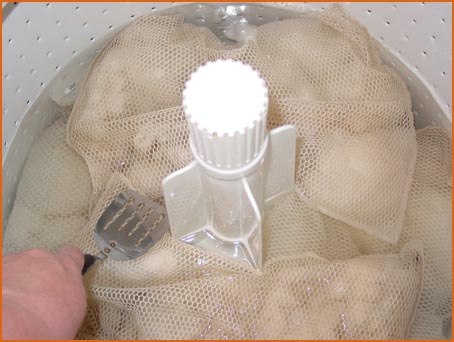

|
Before washing you may want to place handfuls of the fleece into a "fine washable net, zippered bag" (you can get these in the laundry products area at Target, Wal-Mart, etc.). This large bag holds about 1/4 of a pound of wool and will keep it in it's lock formation while soaking. |
You can use your washing machine, *BUT ONLY AS A CONTAINER *. NEVER use the agitation cycle when wool is in the washer. Always fill the washer with the very hottest water (set hot water heater to 140 degrees if possible), ad in the soap and agitate.You can use most any sort of laundry soap (Cheer, Tide, etc.) or dishwashing liquid (Joy, Dawn, etc.) Others like to use Orvus, a livestock animal washing paste from the livestock supply store. Some products make up more suds, froth, than others. I use a clear, odorless, liquid soap concentrate surfactant which is an industrial product purchased from a cleaning supply company. (I like this product because it is slightly acidic and I don't have to use very much at a time.) |

|

|
Then turn the washer completely *OFF* and gently press in the bags of wool without doing any agitation, sloshing, etc. You can use the spin cycle for removing the water, but remove the wool before refilling the washer for the rinsing soaks. |
This is how the tub of wool and soapy water (dirty huh?) will look. For fleece with a very high grease/lanolin content you may want to ad into that first soap soak 2/3 cup of soda ash to the wash load. Combine the soap, hot water, and ash and mix well. Soda ash is NOT the same thing as "washing soda". Soda ash is chemically (atomically different) 10 times stronger than washing soda. It is VERY basic, as in something is either acidic, neutral, or basic in pH. Wool does well in acid, but will disintegrate over time in a basic solution.It's true that pH is an important consideration when washing wool. The pH of most soaps are neutral or a little acidic. The pH of the soda ash is about 8.6 (definitely basic). Don't use more nor leave it to soak any longer than the 20 minutes. The basic soda ash strips the lanolin, while the soap cleans, and in the second wash, restores the proper pH. Most city water systems are neutral (7.) to start with and so present no special problem. Well water, even though "hard" (this refers to mineral content, not pH), may not be overly basic. If you have had your water tested and it is safe to drink, then most likely it is neither too acidic nor too basic. The reason this works so well on wool is that the soda ash strips off the lanolin. *If you are washing some other type of fiber which is not coated with lanolin, or wool with little lanolin, then it makes sense to not add the soda ash to the 1st wash soak. |

|

|
Never let the soaking water cool down, as the lanolin resets into the wool.It's OK to use the spin cycle of your washing machine to remove the water in the tub. The wool is moving in mass around the agitator ... not being agitated, just moving all at once while the water drains out. |
Remove the bags of wool BEFORE turning on the hot water to refill the tank for the soaking rinse.If you have used soda ash, don't let the wool soak for more than 20 minutes, then be sure to do 1 soap only soak and then 1 clean water rinse soak afterwards. When washing wool that isn't very dirty, do only 1 soap soak and 2 clean water soaks. |

|

|
In the final soaking rinse of the wool, this is how it should look ... clean!When you are done, the wet wool should no longer smell like lanolin. If it still smells like lanolin, then later (some months later) you will find that the clean wool has gone stiff and sort of sticky and can't be carded. After the final spin cycle, remove the wool from the zippered bags and spread out on a table on a towel, or better yet, a screen of some sort so the wool can dry. It will usually dry over night. |
[an error occurred while processing this directive]